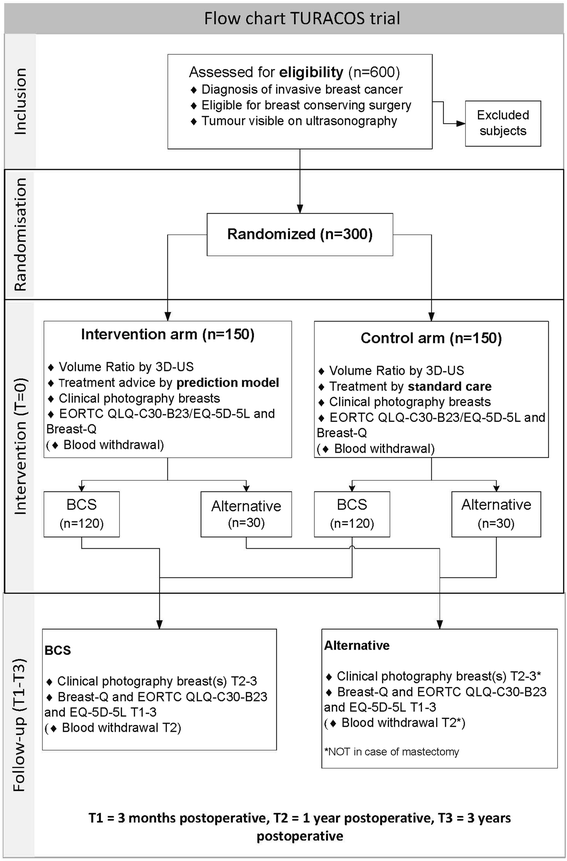TUmor-volume to breast-volume RAtio for improving COSmetic results in breast cancer patients (TURACOS); a randomized controlled trial
- PMID: 28514945
- PMCID: PMC5436425
- DOI: 10.1186/s12885-017-3280-y
TUmor-volume to breast-volume RAtio for improving COSmetic results in breast cancer patients (TURACOS); a randomized controlled trial
Abstract
Background: Cosmetic result following breast conserving surgery (BCS) for cancer influences quality of life and psychosocial functioning in breast cancer patients. A preoperative prediction of expected cosmetic result following BCS is not (yet) standard clinical practice and therefore the choice for either mastectomy or BCS is still subjective. Recently, we showed that tumour volume to breast volume ratio as well as tumour location in the breast are independent predictors of superior cosmetic result following BCS. Implementation of a prediction model including both factors, has not been studied in a prospective manner. This study aims to improve cosmetic outcome by implementation of a prediction model in the treatment decision making for breast cancer patients opting for BCS.
Methods/design: Multicentre, single-blinded, randomized controlled trial comparing standard preoperative work-up to a preoperative work-up with addition of the prediction model. Tumour volume to breast volume ratio and tumour location in the breast will be used to predict cosmetic outcome in invasive breast cancer patients opting for BCS. Three dimensional (3D)-ultrasonography will be used to measure the tumour volume to breast volume ratio needed for the prediction model. Sample size was estimated based on a 14% improvement in incidence of superior cosmetic result one year after BCS (71% in the control group versus 85% in the intervention group). Primarily cosmetic outcome will be evaluated by a 6-member independent panel. Secondary endpoints include; (1) patient reported outcome measured by BREAST-Q, EORTC-QLQ-C30/BR23 and EQ-5D-5 L (2) cosmetic outcome as assessed through the BCCT.core software, (3) radiation-induced reaction (4) surgical treatment performed, (5) pathological result and (6) cost-effectiveness. Follow-up data will be collected for 3 years after surgery or finishing radiotherapy.
Discussion: This randomized controlled trial examines the value of a preoperative prediction model for the treatment-decision making. It aims for a superior cosmetic result in breast cancer patients opting for BCS. We expect improvement of patients' quality of life and psychosocial functioning in a cost-effective way.
Trial registration: Prospectively registered, February 17th 2015, at 'Nederlands Trialregister - NTR4997 '.
References
-
- Early Breast Cancer Trialists' Collaborative G. Darby S, McGale P, Correa C, Taylor C, Arriagada R, et al. Effect of radiotherapy after breast-conserving surgery on 10-year recurrence and 15-year breast cancer death: meta-analysis of individual patient data for 10,801 women in 17 randomised trials. Lancet. 2011;378(9804):1707–1716. doi: 10.1016/S0140-6736(11)61629-2. - DOI - PMC - PubMed
-
- Bartelink H, Horiot JC, Poortmans PM, Struikmans H, Van den Bogaert W, Fourquet A, et al. Impact of a higher radiation dose on local control and survival in breast-conserving therapy of early breast cancer: 10-year results of the randomized boost versus no boost EORTC 22881-10882 trial. J Clin Oncol. 2007;25(22):3259–3265. doi: 10.1200/JCO.2007.11.4991. - DOI - PubMed
-
- Fisher B, Anderson S, Bryant J. Twenty-year follow-up of a randomized trial comparing total mastectomy, lumpectomy, and lumpectomy plus irradiation for the treatment of invasive breast cancer. N Engl J Med. 2002; - PubMed
-
- NABON breast cancer audit (NBCA) poDIfcaD. Jaarrapportage 2013. https://www.dica.nl/jaarrapportage-2013/#dica_rapportages_nbca. Last accessed September 1st 2016.
Publication types
MeSH terms
Associated data
LinkOut - more resources
Full Text Sources
Other Literature Sources
Medical


